Disney Parks Print Star Wars small world WonderGround Mickey Gold Frame Maruyama
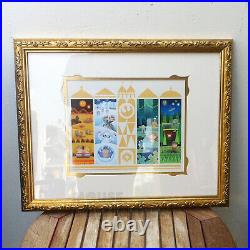
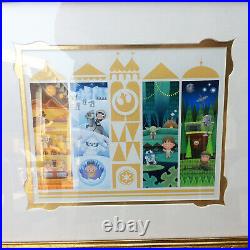
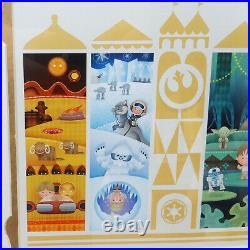
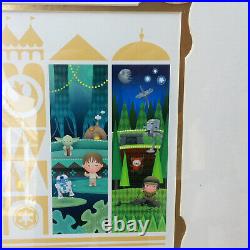



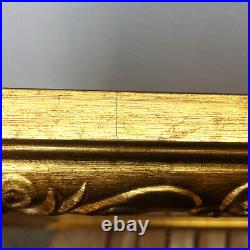


Disney Parks WonderGround Gallery Print. The print has been displayed and is in great condition.
There are small scratches on the edge of the frame and scratches on the back. The art is in excellent condition with no damage. Artwork: It's A Small Galaxy After All. Print Size: 14 x 18 inches.
Frame Size: 16 x 20 inches. Release Date: April 17, 2015. This 2015 print created by Disney artist Jerrod Maruyama invites viewers to travel the Star Wars universe. It includes four iconic locations from the original Star Wars trilogy illustrated in Maruyama's unique kawaii ("cute") style. The Star Wars locations make up the spires of the "it's a small world" Disneyland attraction - making this print a unique mashup.
The locations include Tatooine, Hoth, Dagobah and forest moon Endor. The smiling clock face of "it's a small world" is a symbol of the Rebel Alliance. The symbol of the Empire is at the bottom of the print. "It's A Small Galaxy After All" was released at Disneyland's WonderGround Gallery on April 17, 2015 during Star Wars Celebration weekend. This print is retired and is no longer available. The print is double matted with a gold foil mat and an off white mat. The print measures 14 x 18 inches. The frame measures approximately 16 x 20 inches. The frame has a metallic gold finish. It has raised flourishes with Hidden Mickeys.The Mickey silhouette has a spiral design. The frame has plexiglass to protect the print. Disney's WonderGround Gallery showcases art created by contemporary and modern artists. Artists create original works of art with classic Disney characters, films and attractions in their style resulting in a range of unique collectibles in a variety of media. Popular featured artists include SHAG, Jasmine Becket-Griffith, Jerrod Maruyama, Jeff Granito, Joey Chou and many, many more!
WonderGround Galley has two locations: Downtown Disney at the Disneyland Resort and Disney Springs at the Walt Disney World Resort. Please send a message with any questions. "It's a Small World" is a water-based boat ride located in the Fantasyland area at various Disney theme parks worldwide, including Disneyland Park in Anaheim, California; Magic Kingdom at Walt Disney World Resort in Bay Lake, Florida; Tokyo Disneyland, Disneyland Paris; and Hong Kong Disneyland, with its inaugural version having premiered at the 1964 New York World's Fair before permanently moving to Disneyland. The ride features over 300 audio-animatronic dolls in traditional costumes from cultures around the world, frolicking in a spirit of international unity, and singing the attraction's title song, which has a theme of global peace.Com, the Sherman Brothers' song "It's A Small World" is the most publicly performed song of all time. In recent years, the Small World attractions at the various Disney parks have been updated to include depictions of Disney characters, albeit in a design compatible with the original 1960s design of Mary Blair, alongside the original characters. It was added to four attractions - Magic Skyway (Ford), Great Moments with Mr. Lincoln (Illinois), The Carousel of Progress (General Electric), and CircleVision 360 (Kodak)-already under development, which were used by Disney to sponsor, fund, and test concepts and develop ride systems and innovative entertainment intended to be moved and rebuilt at Disneyland after the World's Fair closed in 1966.
The Pepsi Board of Directors took so long to agree on what type of attraction to sponsor that then-board member and widow of past company president Alfred Steele, actress Joan Crawford, prevailed upon her longtime Hollywood friend Walt Disney to design such an attraction as would be suitable for Pepsi. Because of the short lead-time to design, create, and construct such an attraction, she insisted that the board of directors accept his proposal, seeing as he was already designing attractions for the state of Illinois, Ford, General Electric, and Kodak and knew Walt was the only one who could accomplish such a feat in the short time left until the fair was scheduled to open. The WED Enterprises company was given only 11 months to create and build the pavilion. Mary Blair was responsible for the attraction's whimsical design and color styling. Blair had been an art director on several Disney animated features, including Cinderella, Alice In Wonderland, and Peter Pan. Like many Disneyland attractions, scenes and characters were designed by Marc Davis, while his wife, Alice Davis, designed the costumes for the dolls. Rolly Crump designed the toys and other supplemental figures on display. The animated dolls were designed and sculpted by Blaine Gibson. Walt was personally involved with Gibson's and Greg S.Marinello development of the dolls' facial design; each animated doll face is completely identical in shape. Arrow Development was deeply involved in the design of the passenger-carrying boats and propulsion system of the attraction.
Two patents that were filed by Arrow Development staff and assigned to The Walt Disney Company illustrate passenger boats and vehicle guidance systems with features very similar to those later utilized on the Disneyland installation of the attraction. The firm is credited with manufacturing the Disneyland installation. "Children of the World" was the working title of the attraction. Its tentative soundtrack, which can be heard on the album, featured the national anthems of each country represented throughout the ride all playing all at once, which resulted in disharmonic cacophony. Walt conducted a walk-through of the attraction scale model with his staff songwriters Robert B.
Sherman, saying, I need one song that can be easily translated into many languages and be played as a round. " The Sherman brothers then wrote "It's a Small World (After All) in the wake of the 1962 Cuban Missile Crisis, which influenced the song's message of peace and brotherhood. When they first presented it to Walt, they played it as a slow ballad. Walt requested something more cheerful, so they sped up the tempo and sang in counterpoint.
Walt was so delighted with the final result that he renamed the attraction "It's a Small World" after the Sherman Brothers' song. Sherman, youngest son of Robert B.Sherman, has claimed that this song is the single most-performed and most-translated piece of music. In 2014, it was estimated that the song had played nearly 50 million times worldwide on the attractions alone, beating out the radio and TV estimates for "You've Lost That Lovin' Feelin'" and "Yesterday", which were believed to have been played at least eight and seven million times respectively. A third verse celebrating the attraction's 50th anniversary was written and popularized, but not incorporated into the ride. The first incarnation of It's a Small World, which debuted at the 1964 New York World's Fair, was an afterthought and nearly did not happen.
Ford and General Electric had engaged Disney early on to create their pavilions for the 1964 New York World's Fair. WED Enterprises had already long been at work developing a "dancing-doll" designed to reproduce human movement resulting in a crude early audio-animatronics fashioned as Abraham Lincoln when the State of Illinois approached Disney to create the Illinois Pavilion, representatives of the state instantly approved after being "introduced" to the robotic figurehead. A nine wide-screen CircleVision 360° exhibit for Kodak's pavilion was also being planned as an improvement over the existing Disneyland eleven 4:3 format screen Circarama (which later failed the installation deadline for opening) when Pepsi approached Disney with a plan to tribute UNICEF. Disney seemed to be the showman to give us the package we want... He's got his hands in more bowls than anyone I've ever seen, but he accomplishes what he sets out to do.Mullaly, Ford's World's Fair program manager. April 22, 1964 - opening day. A salute to the children of the world, designed by Walt Disney, presents animated figures frolicking in miniature settings of many lands. Visitors are carried past the scenes in small boats.
In an adjoining building Pepsi sponsors exhibits by the U. Committee for the United Nations Children's Fund.Above the pavilion rises the 120-foot Tower of the Four Winds, a fanciful creation of coloured shapes that dance and twist in the breeze. 1965 Official Guide Book to the New York World's Fair.
The attraction was incredibly successful. Ten million 60¢ and 95¢ tickets for children and adults, respectively, were collected in two half-year seasons and the proceeds were donated to UNICEF. While other attractions had lines out the doors, there seemed to always be a seat available aboard It's a Small World.
Its high rider-per-hour capacity was recognized as a valuable innovation and was incorporated indirectly and directly into future attractions. Pirates of the Caribbean had been under construction at Disneyland as a subterranean walk-through.
That design was scrapped as concrete was broken out so similar boats could sail past scenes which (because the original walk-through scene length was not shortened) were now different each voyage, another concept which forever influenced attraction design and popularity. The boats enter the show building through a tunnel under the Small World clock and emerge from the attraction fifteen minutes later. The show building interior is larger than the façade.Voyagers see animatronic dolls in traditional local costumes singing "It's a Small World (After All)" together, each in their native language. Boats carry voyagers as they visit the regions of the world. Other Disney park installations wind the flume around one large room, emphasizing its theme that the world is small and interconnected. Each installation may vary the countries which are represented and the order in which they appear. The boats are stored behind the facade and go in and out backstage in between the Spanish room.
The Tower of the Four Winds was not relocated to Disneyland's It's a Small World after the New York World's Fair; in its place is an outdoor oval flume and boarding queue decorated with topiary backed by a large, flat facade with stylized cutout turrets, towers and minarets which are vaguely reminiscent of world landmarks (such as the Eiffel Tower and the Leaning Tower of Pisa). The facade was designed by Disney Imagineer Rolly Crump, who was inspired by Mary Blair's styling. Walt Disney asked Rolly to design a large 30-foot clock, a central feature of the exterior façade, with a smiling face that rocks back and forth to a ticking sound.
A parade of wooden dolls in native culture costumes dance out from doors at the base of the Small World clock to an instrumental toy soldier version of "It's a Small World (After All)" in preparation for each quarter-hour, reminiscent of a European automaton clock. The exterior has been subtly repainted over the years, first as all-white with a gold/silver trim (1966), then in various shades of blue (1977), then in pink and white with pastel accents (1992). Portions of the left side of the original façade were removed in 1991 to make room for the entrance to Mickey's Toontown. As of 2020, the facade is white with a gold trim as it was in 1966, except the original gold and silver paint of the clock, the smiling clock face, is now entirely gold leaf.
The façade was repainted back to its original color scheme in 2002. The gardens around the building are decorated with topiary animals. Guests were encouraged to view the popular Remember... Dreams Come True fireworks presentation from the It's a Small World Mall and nearby parade viewing platform built for Light Magic (which had included a smoking area, now relocated under the Monorail track between the Matterhorn Bobsleds and Autopia) to decrease overwhelming crowds gathered for viewing the fireworks spectacular in Plaza and Main Street.
When the ride was moved to Disneyland in 1966, a scene representing Oceania was added to the ride, which was not included at the World's Fair due to time and budget constraints. At the same time, hello and goodbye rooms were added to the attraction, which have also seen several changes over the years. In the 1960s-70's there were stylized cutouts of flowers saying hello and goodbye in different languages, these were then changed to stylized rainbows with cutout butterflies in the 1980s-90's, before changing to nautical theme with stylized boats with different greetings at the turn of the millennium. When Bank of America sponsored the ride, there was also a message in the goodbye room that read: Wherever you go Around the World You're never far From Bank of America. The finale scene also received changes, as originally the color palette was white with colored pastels, such as pink, yellow, and light blue, and in the early 1980s this would be changed to a darker color palette of black, as well as purple and blue.There also used to be a large stylized sun at the end of the finale scene, which would be removed circa 1990 for unknown reasons. In addition, many other scenes also saw subtle changes through the years.
Disneyland's "It's a Small World" was closed from January to November 2008 (closed and reopening in holiday version, skipping the summer season) to receive a major refurbishment. The building's structure was improved, permanent attachments created for the "It's a Small World Holiday" overlay, the water flume replaced and its propulsion upgraded to electric water jet turbines, and the attraction's aging fiberglass boats redesigned in durable plastic. The refurbishment added 29 new Disney characters, each in their native land in a similar manner to the Hong Kong Disneyland version. The refurbishment also restored the original white and pastel colors in the finale, as well as the farewell sun and tapestry, the latter of which hadn't been seen since the 1964-65 World's Fair.
Sylvania has agreed to a twelve-year sponsorship. In 2014, the sponsor logo at the attraction's entrance changed to that of Siemens, the parent company of Sylvania. The sponsorship ended its run after the 2017 Christmas season. Star Wars is an American epic space opera multimedia franchise created by George Lucas, which began with the eponymous 1977 film and quickly became a worldwide pop-culture phenomenon. The franchise has been expanded into various films and other media, including television series, video games, novels, comic books, theme park attractions, and themed areas, comprising an all-encompassing fictional universe.
The original film (Star Wars), retroactively subtitled Episode IV: A New Hope (1977), was followed by the sequels Episode V: The Empire Strikes Back (1980) and Episode VI: Return of the Jedi (1983), forming the original Star Wars trilogy. The subsequently produced sequel trilogy consists of Episode VII: The Force Awakens (2015), Episode VIII: The Last Jedi (2017), and Episode IX: The Rise of Skywalker (2019). All nine films of the'Skywalker saga' were nominated for Academy Awards with wins going to the first two releases. The Star Wars franchise depicts the adventures of characters "A long time ago in a galaxy far, far away", in which humans and many species of aliens (often humanoid) co-exist with robots, or'droids', who may assist them in their daily routines; space travel between planets is common due to lightspeed hyperspace technology. Telecommunication includes two-way audio and audiovisual screens, and holographic projections. A mystical power known as the Force is described in the original film as an energy field created by all living things... [that] binds the galaxy together. Through training and meditation, those whom "the Force is strong with" are able to perform various superpowers (such as telekinesis, precognition, telepathy, and manipulation of physical energy). The Force is wielded by two major knightly orders at conflict with each other: the Jedi, peacekeepers of the Galactic Republic who act on the light side of the Force through non-attachment and arbitration, and the Sith, who use the dark side by manipulating fear and aggression. While Jedi Knights can be numerous, the Dark Lords of the Sith (or'Darths') are intended to be limited to two: a master and their apprentice. Force-wielders are very limited in numbers in comparison to the population. The Jedi and Sith prefer the use of a weapon called a lightsaber, a blade of energy that can cut through virtually any surface and deflect energy bolts. The rest of the population, as well as renegades and soldiers, use laser-powered blaster firearms. In the outer reaches of the galaxy, crime syndicates such as the Hutt cartel are dominant. Bounty hunters are often employed by both gangsters and governments. Illicit activities include smuggling and slavery.The Star Wars film series centers around three sets of trilogies, which are collectively referred to as the "Skywalker saga". They were produced non-chronologically, with Episodes IV-VI (the original trilogy) being released between 1977 and 1983, Episodes I-III (the prequel trilogy) being released between 1999 and 2005, and Episodes VII-IX (the sequel trilogy), being released between 2015 and 2019.
Each trilogy focuses on a generation of the Force-sensitive Skywalker family. The original trilogy depicts the heroic development of Luke Skywalker, the prequels tell the backstory of his father Anakin, while the sequels star Luke's nephew, Kylo Ren. An anthology series set between the main episodes entered development in parallel to the production of the sequel trilogy, described by Disney chief financial officer Jay Rasulo as origin stories. The first entry, Rogue One (2016), tells the story of the rebels who steal the Death Star plans just before Episode IV. Solo (2018) focuses on Han Solo's backstory, also featuring original trilogy co-protagonists Chewbacca and Lando Calrissian and involving prequel trilogy villain Darth Maul. Lucasfilm has a number of Star Wars films in development, two of which were confirmed during Disney Investor Day 2020. The first will be a film titled Rogue Squadron, which is being directed by Patty Jenkins, and is scheduled for release on December 22, 2023. [37] The second is an unspecified film from Taika Waititi, who in May 2020 was announced to be directing a Star Wars film he was co-writing with Krysty Wilson-Cairns. [38] Additionally, a trilogy independent from the Skywalker saga is being written by The Last Jedi writer/director Rian Johnson.[39][40] In September 2019, it was announced that Kathleen Kennedy and Kevin Feige would collaborate to develop a Star Wars film. [41] In February 2020, a film was announced to be in development from director J.
Dillard and writer Matt Owens. The original trilogy's main cast includes (from left to right) Mark Hamill (Luke Skywalker), Harrison Ford (Han Solo), Carrie Fisher (Princess Leia), and James Earl Jones (Darth Vader's voice). In 1971, George Lucas wanted to film an adaptation of the Flash Gordon serial, but could not obtain the rights, so he began developing his own space opera.
After directing American Graffiti (1973), he wrote a two-page synopsis, which 20th Century Fox decided to invest in. By 1974, he had expanded the story into the first draft of a screenplay. The 1977 movie's success led Lucas to make it the basis of an elaborate film serial. With the backstory he created for the sequel, Lucas decided that the series would be a trilogy of trilogies. Most of the main cast would return for the two additional installments of the original trilogy, which were self-financed by Lucasfilm. Star Wars was released on May 25, 1977, and first subtitled Episode IV: A New Hope in the 1979 book The Art of Star Wars.Episode V: The Empire Strikes Back was released on May 21, 1980, also achieving wide financial and critical success. The final film in the trilogy, Episode VI: Return of the Jedi was released on May 25, 1983. The story of the original trilogy focuses on Luke Skywalker's quest to become a Jedi, his struggle with the evil Imperial agent Darth Vader, and the struggle of the Rebel Alliance to free the galaxy from the clutches of the Galactic Empire. The prequel trilogy's main cast includes (from left to right) Ewan McGregor (Obi-Wan Kenobi), Natalie Portman (Padmé Amidala), Hayden Christensen (Anakin Skywalker), [e] and Ian McDiarmid (Palpatine).
According to producer Gary Kurtz, loose plans for a prequel trilogy were developed during the outlining of the original two films. In 1980, Lucas confirmed that he had the nine-film series plotted, but due to the stress of producing the original trilogy, he had decided to cancel further sequels by 1981. In 1983, Lucas explained that There was never a script completed that had the entire story as it exists now... As the stories unfolded, I would take certain ideas and save them... I kept taking out all the good parts, and I just kept telling myself I would make other movies someday. Technical advances in the late 1980s and early 1990s, including the ability to create computer-generated imagery (CGI), inspired Lucas to consider that it might be possible to revisit his saga.In 1989, Lucas stated that the prequels would be unbelievably expensive. In 1992, he acknowledged that he had plans to create the prequel trilogy. A theatrical rerelease of the original trilogy in 1997 "updated" the 20-year-old films with the style of CGI envisioned for the new trilogy. Episode I: The Phantom Menace was released on May 19, 1999, and Episode II: Attack of the Clones on May 16, 2002. Episode III: Revenge of the Sith, the first PG-13 film in the franchise, was released on May 19, 2005.
The first two movies were met with mixed reviews, with the third being received somewhat more positively. The trilogy begins 32 years before Episode IV and follows the Jedi training of Anakin Skywalker, Luke's father, and his eventual fall from grace and transformation into the Sith lord Darth Vader, as well as the corruption of the Galactic Republic and rise of the Empire led by Darth Sidious. Together with the original trilogy, Lucas has collectively referred to the first six episodic films of the franchise as "the tragedy of Darth Vader".